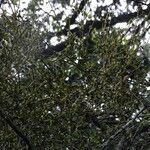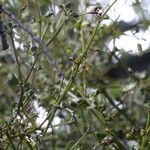Leafy, monoecious, densely branched, often globose shrubs (<0.5 m high), pale yellow to dark green; internodes of distal branches 15-20 x 1-2.5 mm, rounded, usually ribbed. Leaves highly variable, 15-40 x 15-45 mm, spathulate-oblanceolate to obovate-rotund, apically rounded, basally cuneate, sometimes prominently 3-veined, margins often slightly yellowish or minutely whitish crenulate. Bracteal cups sessile, often numerous in dense axillary clusters, the nodes of older stems often conspicuously swollen. Flowers of both sexes sessile, usually unisexual in triads or dyads of the same sex, occasionally single, sometimes also in dichasia with a central pistillate flower subtended laterally by 2 staminate flowers. Style distinct, 0.5 mm long, slightly enlarged basally; stigma slightly or not at all expanded. Berries sessile, orange, 5-6 mm high, ovoid, densely tuberculate when young to moderately tuberculate or nearly smooth at maturity. Ring scar left by perianth 1.5 mm in diameter.
Leafy, monoecious shrubs of moderate size mostly 0.5-1 m high, mostly dark green, densely and intricately branched; younger branches somewhat flattened and 6-ribbed, the rib below the leaves sometimes transformed into a wing; older branches rounded; basal internodes of younger branches mostly 15-20 x 2-3 mm, somewhat dilated at the nodes. Leaves mostly obovate-oblong to orbicular, 20-30 x 12-20 mm, apically rounded, often cuneate into base, 3(5)-nerved from base (sometimes only faintly); petiole subsessile to 3 mm long. Dichasia with central flower typically staminate, lateral pistillate developing a short, stout peduncle c. 1 mm long. Berries subcylindrical, densely warted, truncate when young, at maturity nearly smooth, ellipsoid to globose, 5-6 mm long, pale yellow-orange; style persistent, cylindrical; stigma approximately the diameter of the style. Flowering April through June (possibly longer).
Leafy, monoecious shrub, up to 1 m high, parasitic on species of Grewia, Rhus, Vitex. Internodes of leafy stems 6-ribbed, mostly 15-20 mm long. Berries warted when young, sessile, with persistent linear stigma. Flowers green.
Leaves highly variable, 15–40 × 15–45 mm, spathulate-oblanceolate to obovate-rotund, apically rounded, basally cuneate, sometimes prominently 3-veined, margins often slightly yellowish or minutely whitish crenulate.
Flowers of both sexes sessile, usually unisexual in triads or dyads of the same sex, occasionally single, sometimes also in dichasia with a central pistillate flower subtended laterally by 2 staminate flowers.
A shrub. It is rounded and grows up to 1 m tall. It keeps growing from year to year. The leaves are pale yellow to dark green. The leaves can be spoon shaped or wedge shaped. They are variable.
Leafy, monoecious, densely branched, often globose shrubs (<0.5 m high), pale yellow to dark green; internodes of distal branches 15–20 × 1–2.5 mm, rounded, usually ribbed.
Berries sessile, orange, 5–6 mm high, ovoid, densely tuberculate when young to moderately tuberculate or nearly smooth at maturity.
Bracteal cups sessile, often numerous in dense axillary clusters, the nodes of older stems often conspicuously swollen.
Style distinct, 0.5 mm long, slightly enlarged basally; stigma slightly or not at all expanded.
Ring scar left by perianth 1.5 mm in diameter.




